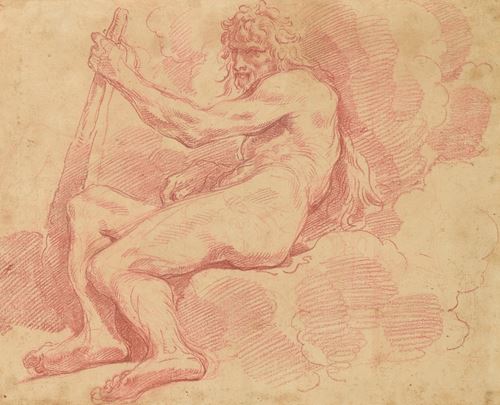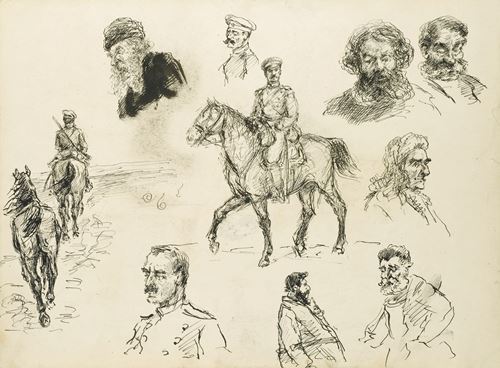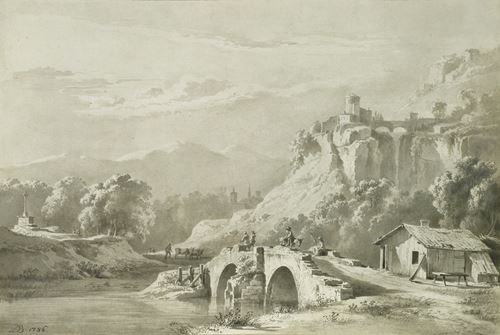ean-Antoine Julien, called Julien de Parme
(Cavigliano 1736 - Paris 1799)
The Marriage of Alexander to Roxana
signed and dated ‘julien I [Invenit]. 1768, à Rome’ (lower right)
black chalk, pen and brown ink, brown and grey wash, heightened with white on lightly washed paper, watermark encircled fleur-de-lys
33.2 x 45.9 cm (13⅛ x 18⅛ in)
Alexander the Great married at least two women: Roxana, daughter of a Sogdian, a noble from what is today modern Uzbekistan; and also the Persian Princess Stateira, daughter of Darius III of Persia. Classical historian Robin Lane Fox writes on Alexander’s marriage, ‘that Roxana was said by contemporaries to be the most beautiful lady in all Asia. She deserved her Iranian name of Roshanak, meaning “little star”. Marriage to a local noble’s family made sound political sense. But contemporaries implied that Alexander, aged 28, also lost his heart. A wedding-feast for the two of them was arranged high on one of the Sogdian rocks. Alexander and his bride shared a loaf of bread, a custom still observed in Turkestan. Characteristically, Alexander sliced it with his sword.’ Alexander fell passionately in love with her and determined to raise her to the position of his consort. Roxana accompanied Alexander all the way to India, and bore him a child, Alexander IV, six months after Alexander the Great died.
Jean-Antoine Julien, known as Julien de Parme, is now recognised as one of the precursors of Neoclassical painting. Born in Switzerland, he settled in Rome in 1760 after a short sojourn in Paris. In Italy his main patron was Guillaume-Léon du Tillot, Marquese of Felino (1711-74), Prime Minister of the Duchy of Parma, who each year commissioned a large historical picture from him. In gratitude to the court of Parma, the artist decided to use the name Julien de Parme. When Felino fell from power in 1772, de Parme decided to follow him into his Parisian exile. In Paris his pictures did not meet with the success he was expecting and his career ended in obscurity and poverty. His Journal and his published correspondence with the Belgian painter André-Corneille Lens (1739-1822) serve as invaluable documents for the artistic life in Rome and Paris at the end of the eighteenth century.
This drawing is a study for The Marriage of Alexander to Roxana painted in 1768 for the court of Parma, now in the Palazzo Pitti, Florence (P. Rosenberg, in Julien de Parme 1736-1799, exhibition catalogue, Rancate, Pinacoteca Cantonale and Parma, Fondazione Magnani-Rocca, 1999-2000, no. 20). The present work was followed by another developed composition closer to the picture now in a French private collection (P. Rosenberg, ibid, no. 21). The composition is typical of de Parme as it shows his equal interest in both Antiquity and in the great masters of the Renaissance. It has often been noted that the initial source of inspiration for de Parme’s composition was a fresco by Il Sodoma, the Italian Mannerist painter, of the same subject at the Villa Farnesina in 1512. This influence is evident in de Parme’s The Marriage of Alexander to Roxana, where the placing and the postures of the principal protagonists of the scene are directly borrowed from Il Sodoma’s composition. The version in the Pitti is closer to the now lost composition by Raphael on which Il Sodoma based his fresco; de Parme would have known this fresco of the subject through an engraving by G.J. Caraglio.
Interestingly, de Parme acquired a drawing at the sale of the famous collection of Pierre-Jean Mariette, then considered to be Raphael’s study for his Marriage of Alexander to Roxana. Long regarded as having been executed by one of the members of his studio, it has been recently reattributed to the master himself (Roma e lo Stile Classico di Raffaello, exhibition catalogue, Mantua and Vienna, 1999, no. 81).
De Parme, was a Swiss painter, active in France and Italy. The son of a stone-mason, he received his initial training in Craveggia under a local artist, Giuseppe Borgnis, with whom he spent two years. By 1760 he was in Rome where he threw himself into a study of the antique. He quickly proclaimed his scorn for such contemporaries or immediate predecessors as Gian Lorenzo Bernini and Carlo Maratti in Italy, and François Lemoyne in France, though he was full of praise for Raphael, Polidoro da Caravaggio, Carracci and Domenichino. Indeed, Domenichino’s work was to exert a very strong influence on him. De Parme’s earliest known extant picture was a life-size painting of Cupid (1762), currently in the Barbieri private collection in Parma, which exemplifies the main features of his style. It is inspired by classical sculpture, and the effect of the careful composition is heightened by the subordination of colour to line.
De Parme travelled to Venice in 1771 but was unimpressed by what he saw there, preferring instead the work of Giulio Romano at the Palazzo del Te in Mantua, through which he passed on his return to Rome. In May 1773 he left Italy for Paris. He did not enter the Académie Royale but enjoyed the patronage of du Tillot. After du Tillot’s death in 1775 de Parme found another patron, Louis-Jules-Barbon Mancini-Mazarini, Duc de Nivernais (1716-98), for whom he was to work for the next twenty years.
Alexander the Great married at least two women: Roxana, daughter of a Sogdian, a noble from what is today modern Uzbekistan; and also the Persian Princess Stateira, daughter of Darius III of Persia. Classical historian Robin Lane Fox writes on Alexander’s marriage, ‘that Roxana was said by contemporaries to be the most beautiful lady in all Asia. She deserved her Iranian name of Roshanak, meaning “little star”. Marriage to a local noble’s family made sound political sense. But contemporaries implied that Alexander, aged 28, also lost his heart. A wedding-feast for the two of them was arranged high on one of the Sogdian rocks. Alexander and his bride shared a loaf of bread, a custom still observed in Turkestan. Characteristically, Alexander sliced it with his sword.’ Alexander fell passionately in love with her and determined to raise her to the position of his consort. Roxana accompanied Alexander all the way to India, and bore him a child, Alexander IV, six months after Alexander the Great died.
Jean-Antoine Julien, known as Julien de Parme, is now recognised as one of the precursors of Neoclassical painting. Born in Switzerland, he settled in Rome in 1760 after a short sojourn in Paris. In Italy his main patron was Guillaume-Léon du Tillot, Marquese of Felino (1711-74), Prime Minister of the Duchy of Parma, who each year commissioned a large historical picture from him. In gratitude to the court of Parma, the artist decided to use the name Julien de Parme. When Felino fell from power in 1772, de Parme decided to follow him into his Parisian exile. In Paris his pictures did not meet with the success he was expecting and his career ended in obscurity and poverty. His Journal and his published correspondence with the Belgian painter André-Corneille Lens (1739-1822) serve as invaluable documents for the artistic life in Rome and Paris at the end of the eighteenth century.
This drawing is a study for The Marriage of Alexander to Roxana painted in 1768 for the court of Parma, now in the Palazzo Pitti, Florence (P. Rosenberg, in Julien de Parme 1736-1799, exhibition catalogue, Rancate, Pinacoteca Cantonale and Parma, Fondazione Magnani-Rocca, 1999-2000, no. 20). The present work was followed by another developed composition closer to the picture now in a French private collection (P. Rosenberg, ibid, no. 21). The composition is typical of de Parme as it shows his equal interest in both Antiquity and in the great masters of the Renaissance. It has often been noted that the initial source of inspiration for de Parme’s composition was a fresco by Il Sodoma, the Italian Mannerist painter, of the same subject at the Villa Farnesina in 1512. This influence is evident in de Parme’s The Marriage of Alexander to Roxana, where the placing and the postures of the principal protagonists of the scene are directly borrowed from Il Sodoma’s composition. The version in the Pitti is closer to the now lost composition by Raphael on which Il Sodoma based his fresco; de Parme would have known this fresco of the subject through an engraving by G.J. Caraglio.
Interestingly, de Parme acquired a drawing at the sale of the famous collection of Pierre-Jean Mariette, then considered to be Raphael’s study for his Marriage of Alexander to Roxana. Long regarded as having been executed by one of the members of his studio, it has been recently reattributed to the master himself (Roma e lo Stile Classico di Raffaello, exhibition catalogue, Mantua and Vienna, 1999, no. 81).
De Parme, was a Swiss painter, active in France and Italy. The son of a stone-mason, he received his initial training in Craveggia under a local artist, Giuseppe Borgnis, with whom he spent two years. By 1760 he was in Rome where he threw himself into a study of the antique. He quickly proclaimed his scorn for such contemporaries or immediate predecessors as Gian Lorenzo Bernini and Carlo Maratti in Italy, and François Lemoyne in France, though he was full of praise for Raphael, Polidoro da Caravaggio, Carracci and Domenichino. Indeed, Domenichino’s work was to exert a very strong influence on him. De Parme’s earliest known extant picture was a life-size painting of Cupid (1762), currently in the Barbieri private collection in Parma, which exemplifies the main features of his style. It is inspired by classical sculpture, and the effect of the careful composition is heightened by the subordination of colour to line.
De Parme travelled to Venice in 1771 but was unimpressed by what he saw there, preferring instead the work of Giulio Romano at the Palazzo del Te in Mantua, through which he passed on his return to Rome. In May 1773 he left Italy for Paris. He did not enter the Académie Royale but enjoyed the patronage of du Tillot. After du Tillot’s death in 1775 de Parme found another patron, Louis-Jules-Barbon Mancini-Mazarini, Duc de Nivernais (1716-98), for whom he was to work for the next twenty years.





 contact
contact +44 20 7313 8040
+44 20 7313 8040









